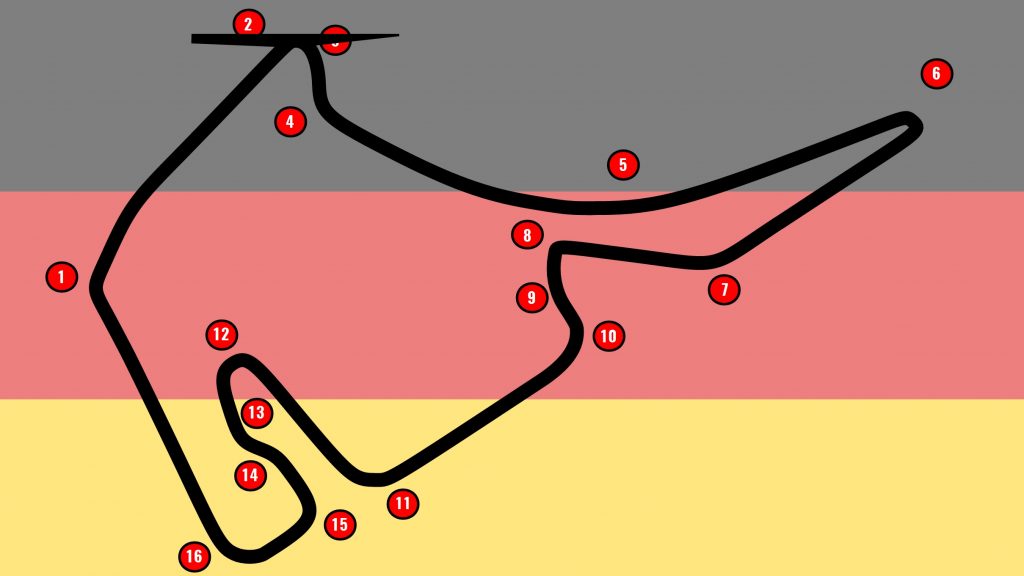The Hockenheimring may be a shadow of its former self since its radical transformation in 2002, but Formula One still loves bringing the sport to the German fans.
FIRST F1 RACE |
1970 |
TRACK LENGTH |
2.842 miles |
NUMBER OF LAPS |
67 |
NUMBER OF TURNS |
16 |
MOST POLES |
Ayrton Senna, Nigel Mansell, Alain Prost (3) |
MOST WINS |
Michael Schumacher (4) |
TRACK MAP

A SHORT HISTORY OF THE HOCKENHEIMRING
The Hockenheimring was the brainchild of Ernst Christ, who received support from Hockenheim’s mayor Phillip Klein when he suggested that a race track should be built in the town in 1930. After the plans were approved by the council on Christmas Day in 1931, construction of the circuit began in 1932 and it opened just two months later to hold its first motorcycle event. The original track was triangular in shape, and was twelve kilometres long. It was amended in 1938 when it was shortened to almost half of its original length, and changed from a triangular shape to an oval shape. The infamous Ostkurve corner was also added. The track surface was badly damaged by tanks over the years of the Second World War, but racing returned to the circuit in 1947; albeit at only a national level for many years.
Germany’s history with Grand Prix racing harks back to the 1920s, with the AVUS track hosting the German Grand Prix in 1926. The race was marred by an accident in which three people were killed when one of the cars hit a marshal’s hut. No further Grands Prix were held at that track until 1959. Instead, the race moved to the Nurburgring – also known as The Green Hell due to its long and unforgiving nature. The Nordschleife track, which was over seventeen miles long and featured 174 bends, was deemed too dangerous by Formula One’s standards in the 1970s and the German Grand Prix moved to Hockenheim.
The Hockenheimring first hosted the German Grand Prix in 1970 and it attracted 100,000 spectators. The event was set up with short notice, as the drivers had agreed to boycott a potential race at the Nurburgring due to its safety standards. The Hockeheim track had recently been altered after a motorway was planned to be built right through the circuit in the 1966. This led to the organisers receiving compensation money to alter the track, adding the ‘Motodrom’ stadium section. Two chicanes had been added in 1970 to slow the drivers down on the straights following the death of Jim Clark in a Formula Two event in 1968.
However, with safety requirements at the Nurburgring being carried out, F1 moved back to that track for 1971, and remained there until 1976. Following Niki Lauda’s near-fatal crash on the Nordschleife track though, the sport never visited the full version of that circuit again. For 1977, the Grand Prix circus was back at Hockenheim and this track remained the home of the German Grand Prix through to 2008 – except for 1985 when it was run at a renovated Nurburgring circuit. The Nurburgring itself hosted the European Grand Prix on a regular basis up until 2007.
Another chicane was added to the layout following the death of Patrick Depailler in a crash during testing in 1980. Rain and spray was an issue here, with the cars reaching 200mph maximum speeds on the straights which were surrounded by trees. This limited visibility as there was nowhere for the spray to go. Didier Pironi suffered a career-ending accident here in 1982, in part due to that exact issue. The track has always evolved when an incident has occurred. Further changes were made to the Ostkurve in 1992 following a crash for Érik Comas there in 1991.
The track was radically shortened by Herman Tilke’s design company in 2002 following pressure from F1 officials for the track to meet modern day F1 standards. The shortened track was not particularly well favoured when compared to the old layout, but it was more compact, increased spectator capacity and, most importantly, was safer. While the stadium section was largely unchanged, gone were the long straights and the infamous Ostkurve.
In 2008, Hockenheim and the Nurburgring were scheduled to begin alternating hosting the German Grand Prix on a yearly basis. This carried on until 2014, when the Nurburgring organisers hit financial trouble. The German Grand Prix has since held every other year solely at the Hockenheim track, though the Nurburgring does have hopes of fulfilling its contract in the future. The Hockenheimring’s contract to host the German Grand Prix is currently being extended on a year-by-year basis.
?? 2018 RACE RECAP
Sebastian Vettel crashed out of his home Grand Prix in tricky conditions, leaving Lewis Hamilton to win from fourteenth on the grid.
Formula One’s return to Germany for the first time since 2016 saw Sebastian Vettel take pole at his home Grand Prix. Lewis Hamilton suffered with mechanical issues in Q1, leaving him stranded out on the circuit and starting down in fourteenth. Vettel maintained the lead in the opening stages, pitting on lap 26 leaving Kimi Raikkonen in the lead. Daniel Ricciardo had started near the back after power unit penalties, but further issues on Sunday put him out of the race before half-distance. As Raikkonen was told to get out of the way of his faster team-mate, the skies grew ever darker. Hamilton pitted for fresh tyres regardless, rejoining in fifth after having made his way through the field. The rain soon began to pour, but Pierre Gasly’s stop for wet tyres proved to be a little too early. Disaster struck for Vettel on lap 52 as he crashed out of the race on the damp track, prompting a Safety Car period. Confusion reigned at Mercedes; Valtteri Bottas had a slow stop while Hamilton was told to pit, then stay out then pit. He crossed the pit entry line to stay on the track, but took the lead. When the Safety Car period ended, Bottas challenged Hamilton for the lead before being told to hold position. Mercedes took their first 1-2 finish on home soil as Hamilton re-took the championship lead. Raikkonen completed the podium finishers. There was post-race drama as Hamilton was summoned to the stewards for his earlier pit-lane misdemeanours. The race result was eventually confirmed hours after the chequered flag. Hamilton received a reprimand for the incident, but kept his win.
ARTICLE CONTINUES BELOW
?? DID YOU KNOW?
Aside from being a race track, Hockenheim also occasionally hosts music events. The Sonisphere Festival was held here in 2009 and other acts to have performed here include The Rolling Stones, Robbie Williams and Michael Jackson, who brought his mammoth Bad World Tour here in 1988.
FAST FACTS
- The drivers are on the throttle for 60% of the lap, with a top speed of around 217mph just before Turn 6.
- Nico Rosberg and the Schumacher brothers are the only German drivers to have won at Hockenheim.
- The fastest turn on this track is Turn 7, which is taken at 180mph.
- The track is located in the Rhine Valley and as such is very flat. The highest part of the track sits 152.5m above sea level while the lowest part is 148.2m above sea level.
- The drivers make 49 gear changes per lap here – that’s 3,283 in total over the Grand Prix.
- The 2000 event was interrupted by an intruder on the track – a disgruntled former Mercedes employee. The event, and the timing of the Safety Car, handed Ferrari’s Rubens Barrichello the first win of his F1 career.
- There have been just 3 safety car periods since the track was re-profiled in 2002.
- The second chicane was re-named in Ayrton Senna’s honour following his death in 1994.
- When the track was redesigned in 2002, the old forest part of the circuit was torn up and had trees planted on the land, ensuring F1, or any other category of racing, would never race on the iconic and historic sections of track again. The move was met with much controversy.
- With the circuit being a long way from the nearest city, most of the fans who attend the race use the camp sites around the track. It’s always a party atmosphere.
?? WHY WE LOVE THE HOCKENHEIMRING
Germany has produced some of F1’s highest achievers – from Michael Schumacher to Mercdes Benz. Though the Hockenheim track is nearly unrecognisable from its earliest form, it’s great that the passionate German fans still come out in force for Formula One’s biennial visit.
?? HOCKENHEIM GRAND PRIX WINNERS AND POLESITTERS
Year | Polesitter | Team On Pole | Winner | Winning Team |
|---|---|---|---|---|
1970 | Jacky Ickx | Ferrari | Jochen Rindt | Lotus |
1977 | Jody Scheckter | Wolf | Niki Lauda | Ferrari |
1978 | Mario Andretti | Lotus | Mario Andretti | Lotus |
1979 | Jean-Pierre Jabouille | Renault | Alan Jones | Williams |
1980 | Alan Jones | Williams | Jacques Laffite | Ligier |
1981 | Alain Prost | Renault | Nelson Piquet | Brabham |
1982 | Didier Pironi | Ferrari | Patrick Tambay | Ferrari |
1983 | Patrick Tambay | Ferrari | René Arnoux | Ferrari |
1984 | Alain Prost | McLaren | Alain Prost | McLaren |
1986 | Keke Rosberg | McLaren | Nelson Piquet | Williams |
1987 | Nigel Mansell | Williams | Nelson Piquet | Williams |
1988 | Ayrton Senna | McLaren | Ayrton Senna | McLaren |
1989 | Ayrton Senna | McLaren | Ayrton Senna | McLaren |
1990 | Ayrton Senna | McLaren | Ayrton Senna | McLaren |
1991 | Nigel Mansell | Williams | Nigel Mansell | Williams |
1992 | Nigel Mansell | Williams | Nigel Mansell | Williams |
1993 | Alain Prost | Williams | Alain Prost | Williams |
1994 | Gerhard Berger | Ferrari | Gerhard Berger | Ferrari |
1995 | Damon Hill | Williams | Michael Schumacher | Benetton |
1996 | Damon Hill | Williams | Damon Hill | Williams |
1997 | Gerhard Berger | Benetton | Gerhard Berger | Benetton |
1998 | Mika Häkkinen | McLaren | Mika Häkkinen | McLaren |
1999 | Mika Häkkinen | McLaren | Eddie Irvine | Ferrari |
2000 | David Coulthard | McLaren | Rubens Barrichello | Ferrari |
2001 | Juan Pablo Montoya | Williams | Ralf Schumacher | Williams |
2002 | Michael Schumacher | Ferrari | Michael Schumacher | Ferrari |
2003 | Juan Pablo Montoya | Williams | Juan Pablo Montoya | Williams |
2004 | Michael Schumacher | Ferrari | Michael Schumacher | Ferrari |
2005 | Kimi Raikkonen | McLaren | Fernando Alonso | Renault |
2006 | Kimi Raikkonen | McLaren | Michael Schumacher | Ferrari |
2008 | Lewis Hamilton | McLaren | Lewis Hamilton | McLaren |
2010 | Sebastian Vettel | Red Bull | Fernando Alonso | Ferrari |
2012 | Fernando Alonso | Ferrari | Fernando Alonso | Ferrari |
2014 | Nico Rosberg | Mercedes | Nico Rosberg | Mercedes |
2016 | Nico Rosberg | Mercedes | Lewis Hamilton | Mercedes |
2018 | Sebastian Vettel | Ferrari | Lewis Hamilton | Mercedes |
2019 | Lewis Hamilton | Mercedes | Max Verstappen | Red Bull |
